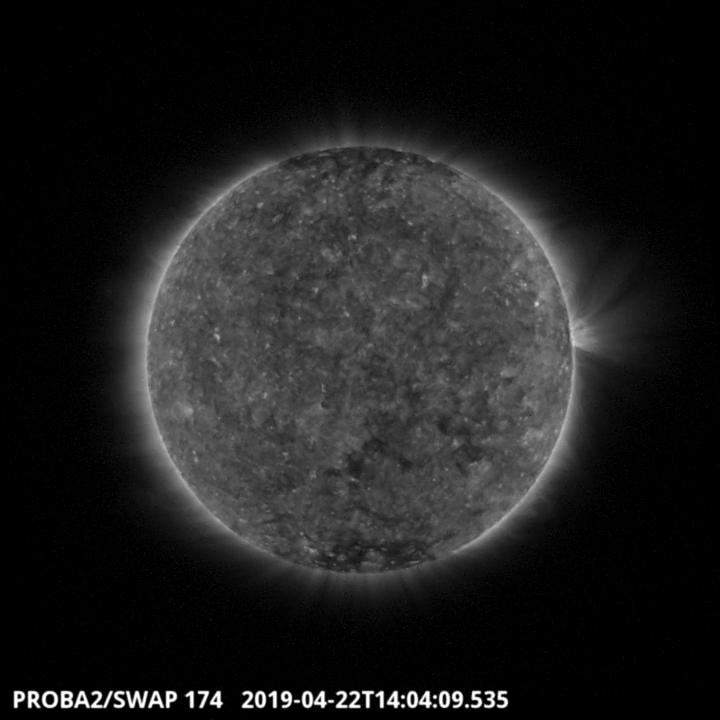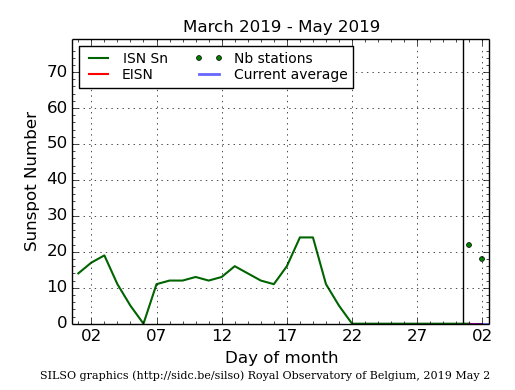- Table of Content
- 1.PECASUS for ci...
- 2.PROBA2 Observa...
- 3.Review of sola...
- 4.The Internatio...
- 5.Geomagnetic Ob...
- 6.Review of iono...
2. PROBA2 Observations (22 Apr 2019 - 28 Apr 2019)
3. Review of solar and geomagnetic activity
4. The International Sunspot Number
5. Geomagnetic Observations at Dourbes (22 Apr 2019 - 28 Apr 2019)
6. Review of ionospheric activity (22 Apr 2019 - 28 Apr 2019)
PECASUS for civil aviation: come and listen on June 6
The STCE will celebrate during its annual meeting on June 6 that PECASUS, in which the STCE is an important partner, is selected as one of the three global Space Weather centers. PECASUS is a European network that provides civil aviation information on space weather that has the potential to affect communications, navigation and the health of passengers and crew.
Check the program: https://events.oma.be/indico/event/64/

PROBA2 Observations (22 Apr 2019 - 28 Apr 2019)
Solar Activity
Solar flare activity was very low during the week.
In order to view the activity of this week in more detail, we suggest to go to the following website from which all the daily (normal and difference) movies can be accessed: http://proba2.oma.be/ssa
This page also lists the recorded flaring events.
A weekly overview movie can be found here (SWAP week 474): http://proba2.oma.be/swap/data/mpg/movies/weekly_movies/weekly_movie_2019-04-22.mp4
Details about some of this week's events, can be found further below.
If any of the linked movies are unavailable they can be found in the P2SC movie repository here: http://proba2.oma.be/swap/data/mpg/movies/
Monday Apr 22

An extended coronal hole transited the solar meridian on 2019-Apr-22 around 14:00 UT and is visible in the SWAP image above. Find a movie of the events here (SWAP movie): http://proba2.oma.be/swap/data/mpg/movies/20190422_swap_movie.mp4
Review of solar and geomagnetic activity
SOLAR ACTIVITY
Solar activity was very low. There were no active regions or sunspots on the visible solar disc, and as a consequence no flares were observed.
No Earth directed CMEs were detected.
A negative polarity coronal hole crossed central meridian on April 19. Two patchy and faint negative polarity coronal holes crossed central meridian on April 23 and 24.
GEOMAGNETIC ACTIVITY
Geomagnetic activity was quiet to unsettled most of the week. Geomagnetic conditions reached active levels locally at Dourbes (K = 4) between 00:00 UT and 03:00 UT on April 24. At planetary level, Kp was at 3 between 18:00 UT on April 23 and 03:00 UT on April 24. This was due to the arrival of a solar wind stream from the negative polarity coronal hole that traversed central meridian on April 19. The effect was weak, as the solar wind speed did not go beyond 430 km/s with interplanetary magnetic fields up to 11 nT, with Bz reaching -8nT.
The two patchy coronal holes that crossed central meridian later in the week did not have any visible effect at the Earth.
The International Sunspot Number

The daily Estimated International Sunspot Number (EISN, red curve with shaded error) derived by a simplified method from real-time data from the worldwide SILSO network. It extends the official Sunspot Number from the full processing of the preceding month (green line). The plot shows the last 30 days (about one solar rotation). The horizontal blue line shows the current monthly average, while the green dots give the number of stations included in the calculation of the EISN for each day.
Review of ionospheric activity (22 Apr 2019 - 28 Apr 2019)

The figure shows the time evolution of the Vertical Total Electron Content (VTEC) (in red) during the last week at three locations:
a) in the northern part of Europe(N61°, 5°E)
b) above Brussels(N50.5°, 4.5°E)
c) in the southern part of Europe(N36°, 5°E)
This figure also shows (in grey) the normal ionospheric behaviour expected based on the median VTEC from the 15 previous days.
The VTEC is expressed in TECu (with TECu=10^16 electrons per square meter) and is directly related to the signal propagation delay due to the ionosphere (in figure: delay on GPS L1 frequency).
The Sun's radiation ionizes the Earth's upper atmosphere, the ionosphere, located from about 60km to 1000km above the Earth's surface.The ionization process in the ionosphere produces ions and free electrons. These electrons perturb the propagation of the GNSS (Global Navigation Satellite System) signals by inducing a so-called ionospheric delay.
See http://stce.be/newsletter/GNSS_final.pdf for some more explanations ; for detailed information, see http://gnss.be/ionosphere_tutorial.php
